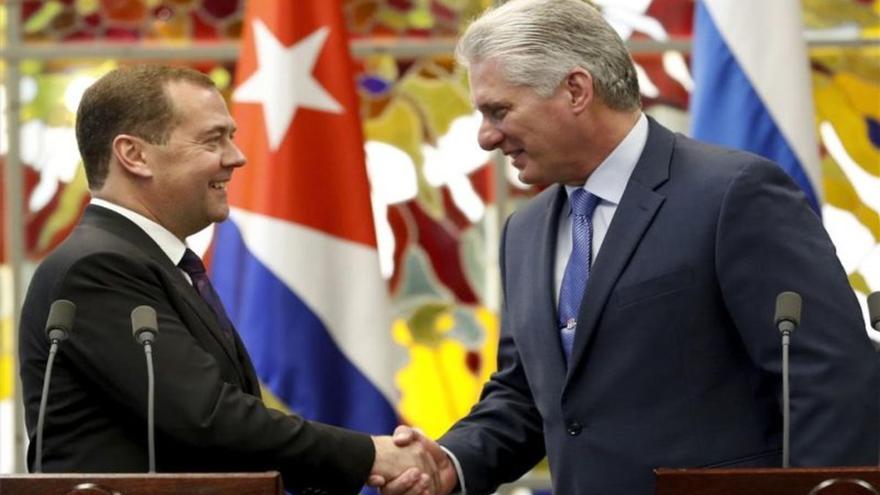
![]() 14ymedio, Havana, 8 October 2019 — Moscow returns with force to Cuba: investments in oil exploration, railroads, sales of military equipment and a water bottling plant. All this from the hand of Russian Prime Minister Dimitri Medvedev, who was received last week in Havana as the great ally who will help the government of Diaz-Canel to overcome the serious energy crisis that the country suffers in the wake of the decline of support from Venezuela and confrontation with the United States
14ymedio, Havana, 8 October 2019 — Moscow returns with force to Cuba: investments in oil exploration, railroads, sales of military equipment and a water bottling plant. All this from the hand of Russian Prime Minister Dimitri Medvedev, who was received last week in Havana as the great ally who will help the government of Diaz-Canel to overcome the serious energy crisis that the country suffers in the wake of the decline of support from Venezuela and confrontation with the United States
Russia aspires to become Havana’s main partner, although in this relationship the old subsidy paradigms that governed relations between the Kremlin and the Plaza of the Revolution in the years of the Soviet Union do not prevail. Instead, the Russians are now more cautious and pragmatic but with similar strategic interests.
The Eurasian power has the Cuban railways in its sights. An extensive network of rails that is among the oldest in the world and which has suffered, in the last three decades, a significant deterioration of its infrastructure and machinery. In just five years, between 2013 and 2018, trains went from transporting ten million passengers a year to just over six, according to official data.
In an attempt to save the most economical means of transporting passengers, in addition to being vital for the movement of goods, two years ago Vladimir Putin promised two billion dollars for this sector, of which 220 million will be invested before 2020.
Fifty-one of the 75 planned locomotives have already arrived on the Island, allowing the restoration of passenger routes that had not been operatiing for several years, such as the connection between Havana and Holguin. However, the equipment has not been able to function at full capacity due to the poor condition of the rail and, recently, due to the crisis in the supply of hydrocarbons.
In the manner of the years of greatest link between Cuba and the USSR, support to relaunch the railway also includes the arrival of 200 Russian technicians to the country who will advise local employees on the use of the equipment. Next year, 80 of the planned 300 railcars are scheduled to be delivered.
Another strategic sector that is targeted by Moscow is water. Holding Aqua, a Russian company specializing in the extraction, distribution and marketing of mineral water, seeks to invest 1.5 million dollars in a new line of the bottled product, widely demanded by tourists visiting the Island.
A signal that reinforces the evident Russian interest in the Island came from the deputy head of the administration of the Russian Government, Sergey Prijodko. The official revealed that “Russia would be willing to be Cuba’s strategic partner” in the atomic energy industry, although he warned that initially it would involve “interesting projects on the use of the atom without relation to energy. Specifically, it is about the use of nuclear technology in medicine and agriculture.”
The clarification has failed to calm the fears of a return to plans to install a nuclear reactor in Cuba, as the Soviet Union had once done. With an intended project of four plants, each with a generating power of 440 megawatts of power, construction began on the first in Juraguá, Cienfuegos, but it was finally abandoned without finishing it in 1992.
Oil, the product that is causing the current energy tension on the Island, is also one of the points of cooperation between the two nations. Russia will allocate 110 million dollars to search for oil on the Island and, during his visit, Medvedev visited the drilling of a well which is expected to yield oil and gas. The project, in Boca de Jaruco, Mayabeque, is under the control of the Russian oil company Zarubezhneft and the state-owned Cuba-Petroleum (Cupet).
Nor could we fail to mention the purchase of military equipment, which the director of the Federal Service of Military Technical Cooperation, Dmitri Shugáev, valued at 43 million dollars last February.
Amid growing tensions with the Trump Administration, Havana has raised the level of belligerence of its political discourse. The renewal of part of its arsenal fits into the strategy of the so-called “military invulnerability” that was talked about come years ago in Cuba’s official media, but which had lost prominence in the last decade.
________________
The 14ymedio team is committed to serious journalism that reflects the reality of deep Cuba. Thank you for joining us on this long road. We invite you to continue supporting us, but this time by becoming a member of 14ymedio. Together we can continue to transform journalism in Cuba.
